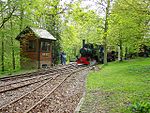Hucking
Borough of MaidstoneCivil parishes in KentHamlets in Kent

Hucking is a small hamlet and civil parish in the Maidstone District of Kent, England. It is located 4 miles (6.4 km) north-east of Maidstone and 5 miles (8.0 km) south-west of Sittingbourne. The parish is governed by a parish meeting. The settlement sits atop the North Downs in a designated Area of Outstanding Natural Beauty (AONB) near the villages of Hollingbourne, Detling, Bicknor (where the population is included for census purposes) and Wormshill and between the main A249 and B2163 roads connecting the towns of Sittingbourne and Maidstone. The parish church is dedicated to St Margaret.
Excerpt from the Wikipedia article Hucking (License: CC BY-SA 3.0, Authors, Images).Hucking
Hazel Street Road,
Geographical coordinates (GPS) Address Nearby Places Show on map
Geographical coordinates (GPS)
| Latitude | Longitude |
|---|---|
| N 51.293 ° | E 0.65 ° |
Address
Hazel Street Road
Hazel Street Road
ME9 7SB
England, United Kingdom
Open on Google Maps







